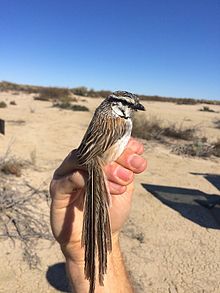Grey grasswren
| Grey grasswren | |
|---|---|
 |
|
| Grey grasswren - Narriearra (north western New South Wales) | |
| Scientific classification | |
| Kingdom: | Animalia |
| Phylum: | Chordata |
| Class: | Aves |
| Order: | Passeriformes |
| Family: | Maluridae |
| Genus: | Amytornis |
| Species: | A. barbatus |
| Binomial name | |
|
Amytornis barbatus Favaloro & McEvey, 1968 |
|
| Subspecies | |
|
see text |
|
see text
The grey grasswren (Amytornis barbatus) is a passerine bird of the family Maluridae native to inland Australia. It is a rarely seen elusive bird that was first sighted in 1921 but not taxonomically described until 1968. This bird belongs to the Family Maluridae which comprises five genera of passerine birds that are only found in Australia and New Guinea. There are two assemblages, Amytorniae which comprise one genus (Amytornis) and eight species, one of which belongs to the grey grasswren. The second assemblage (Malurinae) contains 4 genera and 17 species. The grey grasswren is endemic to Australia and its greyish coloration and very long tail distinguish it from other grasswrens. Two subspecies, Amytornis barbatus barbatus and Amytornis barbatus diamantina have been recognized. While some research has been conducted on the grey grasswren, there remains many knowledge gaps about the ecology of this cryptic bird.
This is a small bird ranging in length between 18–20 cm, a wing span of approximately 21 cm and weighing between 15 and 23 g. Its general colour is gingery brown suffused with grey and off white striations. A diagnosis by Schrodde and Christidis (1987) records that 'the face is patterned black and white with broad white superciliary stripe and black stripe from lores through eyes linked to thin black malar line around sides of throat; tail greatly attenuated with tapered rectrices, the center pair of which extend > 5mm beyond the adjacent pair; no sexual dimorphism in colour of flanks or belly'. Juvenile color is duller although similar to the adults and with no distinct facial pattern. Molt is poorly understood but thought to occur annually after breeding and between October and December.
Two subspecies are recognized:
Favaloro and McEvey (1968) described the call of the grey grasswren as a soft doubled syllabled note which the bird tweeted persistently. Joseph (1982) also noted that calls were given constantly over several minutes with a series of three or four high pitched metallic notes, sounding like 'pit-choo'. Carpenter (2002) described the call as a high pitched 'sit-sit-sit'. Further research is necessary to describe the song of this bird.
The breeding behaviour of this species has not been extensively documented but it is thought that the species breeds in July/August usually after flooding or heavy rain. Hardy (2002) however recorded breeding during heavy drought with no local surface water in the study area for at least seven years. The semi-domed nest is built in lignum or cane grass, between 30 and 75 cm above ground level. Favaloro and McEvey (1968) noted that the nest was a large well camouflaged nest, very loosely constructed from grass with a large opening on the side. Clutch size is thought to be two eggs with an average weight of 2.4 g. Egg color is dull, white speckled all over with nutmeg brown, nutmeg to reddish-brown or cinnamon brown markings. There is considerable colour variation between eggs within the nest and also between nests. The female is solely responsible for the incubation of the eggs which is estimated at 13 to 15 days. Both parents attend to the feeding of the hatchlings and no details are known of its breeding success. The Malurie family is known to include species such as the white-throated grasswren (Amytornis woodwardi) thick-billed grasswren (Amytornis purnelli) that use cooperative breeding to improve reproductive success. However, research conducted on the striated grasswren (Amytornis striatus) suggests that this species is socially monogamous with low levels of cooperative breeding. Further research is required to understand further aspects of its social and breeding characteristics.
...
Wikipedia

